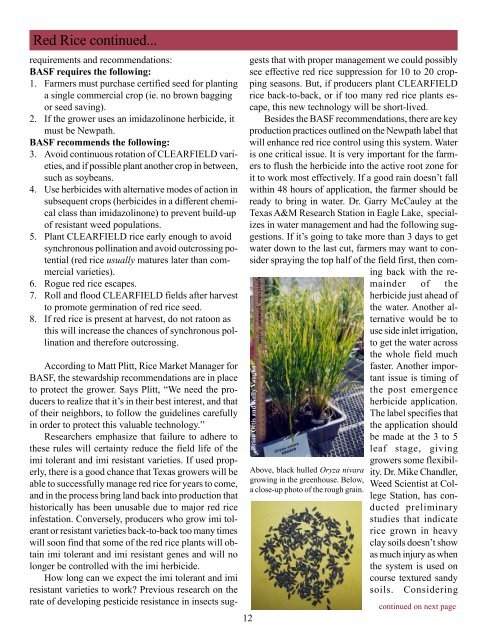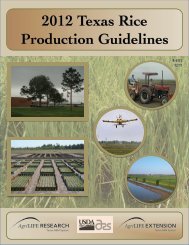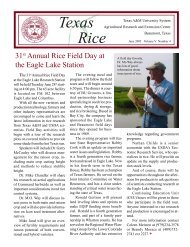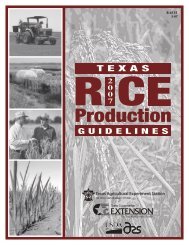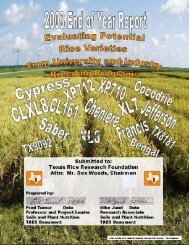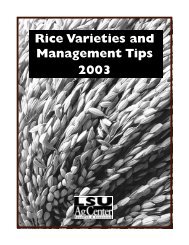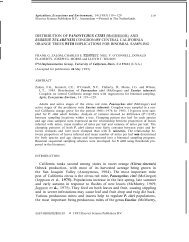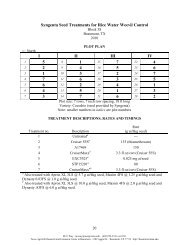Texas Rice - Texas A&M AgriLIFE Research Center at Beaumont ...
Texas Rice - Texas A&M AgriLIFE Research Center at Beaumont ...
Texas Rice - Texas A&M AgriLIFE Research Center at Beaumont ...
You also want an ePaper? Increase the reach of your titles
YUMPU automatically turns print PDFs into web optimized ePapers that Google loves.
Red <strong>Rice</strong> continued...<br />
requirements and recommend<strong>at</strong>ions:<br />
BASF requires the following:<br />
1. Farmers must purchase certified seed for planting<br />
a single commercial crop (ie. no brown bagging<br />
or seed saving).<br />
2. If the grower uses an imidazolinone herbicide, it<br />
must be Newp<strong>at</strong>h.<br />
BASF recommends the following:<br />
3. Avoid continuous rot<strong>at</strong>ion of CLEARFIELD varieties,<br />
and if possible plant another crop in between,<br />
such as soybeans.<br />
4. Use herbicides with altern<strong>at</strong>ive modes of action in<br />
subsequent crops (herbicides in a different chemical<br />
class than imidazolinone) to prevent build-up<br />
of resistant weed popul<strong>at</strong>ions.<br />
5. Plant CLEARFIELD rice early enough to avoid<br />
synchronous pollin<strong>at</strong>ion and avoid outcrossing potential<br />
(red rice usually m<strong>at</strong>ures l<strong>at</strong>er than commercial<br />
varieties).<br />
6. Rogue red rice escapes.<br />
7. Roll and flood CLEARFIELD fields after harvest<br />
to promote germin<strong>at</strong>ion of red rice seed.<br />
8. If red rice is present <strong>at</strong> harvest, do not r<strong>at</strong>oon as<br />
this will increase the chances of synchronous pollin<strong>at</strong>ion<br />
and therefore outcrossing.<br />
12<br />
According to M<strong>at</strong>t Plitt, <strong>Rice</strong> Market Manager for<br />
BASF, the stewardship recommend<strong>at</strong>ions are in place<br />
to protect the grower. Says Plitt, “We need the producers<br />
to realize th<strong>at</strong> it’s in their best interest, and th<strong>at</strong><br />
of their neighbors, to follow the guidelines carefully<br />
in order to protect this valuable technology.”<br />
<strong>Research</strong>ers emphasize th<strong>at</strong> failure to adhere to<br />
these rules will certainty reduce the field life of the<br />
imi tolerant and imi resistant varieties. If used properly,<br />
there is a good chance th<strong>at</strong> <strong>Texas</strong> growers will be<br />
able to successfully manage red rice for years to come,<br />
and in the process bring land back into production th<strong>at</strong><br />
historically has been unusable due to major red rice<br />
infest<strong>at</strong>ion. Conversely, producers who grow imi tolerant<br />
or resistant varieties back-to-back too many times<br />
will soon find th<strong>at</strong> some of the red rice plants will obtain<br />
imi tolerant and imi resistant genes and will no<br />
longer be controlled with the imi herbicide.<br />
How long can we expect the imi tolerant and imi<br />
resistant varieties to work? Previous research on the<br />
r<strong>at</strong>e of developing pesticide resistance in insects suggests<br />
th<strong>at</strong> with proper management we could possibly<br />
see effective red rice suppression for 10 to 20 cropping<br />
seasons. But, if producers plant CLEARFIELD<br />
rice back-to-back, or if too many red rice plants escape,<br />
this new technology will be short-lived.<br />
Besides the BASF recommend<strong>at</strong>ions, there are key<br />
production practices outlined on the Newp<strong>at</strong>h label th<strong>at</strong><br />
will enhance red rice control using this system. W<strong>at</strong>er<br />
is one critical issue. It is very important for the farmers<br />
to flush the herbicide into the active root zone for<br />
it to work most effectively. If a good rain doesn’t fall<br />
within 48 hours of applic<strong>at</strong>ion, the farmer should be<br />
ready to bring in w<strong>at</strong>er. Dr. Garry McCauley <strong>at</strong> the<br />
<strong>Texas</strong> A&M <strong>Research</strong> St<strong>at</strong>ion in Eagle Lake, specializes<br />
in w<strong>at</strong>er management and had the following suggestions.<br />
If it’s going to take more than 3 days to get<br />
w<strong>at</strong>er down to the last cut, farmers may want to consider<br />
spraying the top half of the field first, then coming<br />
back with the remainder<br />
of the<br />
herbicide just ahead of<br />
the w<strong>at</strong>er. Another altern<strong>at</strong>ive<br />
would be to<br />
use side inlet irrig<strong>at</strong>ion,<br />
to get the w<strong>at</strong>er across<br />
the whole field much<br />
faster. Another important<br />
issue is timing of<br />
the post emergence<br />
herbicide applic<strong>at</strong>ion.<br />
The label specifies th<strong>at</strong><br />
the applic<strong>at</strong>ion should<br />
Brian Ottis and Kelly Vaughn<br />
Above, black hulled Oryza nivara<br />
growing in the greenhouse. Below,<br />
a close-up photo of the rough grain.<br />
be made <strong>at</strong> the 3 to 5<br />
leaf stage, giving<br />
growers some flexibility.<br />
Dr. Mike Chandler,<br />
Weed Scientist <strong>at</strong> College<br />
St<strong>at</strong>ion, has conducted<br />
preliminary<br />
studies th<strong>at</strong> indic<strong>at</strong>e<br />
rice grown in heavy<br />
clay soils doesn’t show<br />
as much injury as when<br />
the system is used on<br />
course textured sandy<br />
soils. Considering<br />
continued on next page


